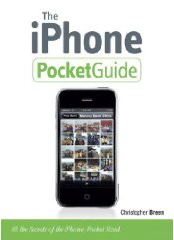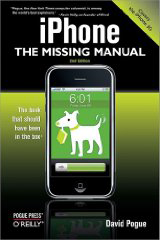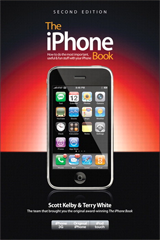iPhone Pocket Guide, 3rd Edition
Christopher Breen
Peachpit Press
http://www.peachpit.com/store/product.aspx?isbn=0321564030
US $ 9.99
ISBN 978-0321564030
288 pages

iPhone The Missing Manual Second Edition (Covers the iPhone 3G)
David Pogue
US $24.99
ISBN 78-0596521677
376 pages
e-book edition available through iTunes Store $4.99 introductory price

The iPhone Book: How to Do the Most Important, Useful & Fun Stuff with Your iPhone, 2nd Edition
Scott Kelby and Terry White
Peachpit Press
http://www.peachpit.com/store/product.aspx?isbn=0321577833
US $19.99
ISBN 978-0321577832
336 pages
Adobe Reader PDF version for Mac and Windows only $15.99

While the press lauds the iPhone user interface for its simplicity and ease of use, there’s more to it than meets the eye. As always, Apple’s documentation leaves much to be desired (and discovered), thus leaving a big market for authors to fill.
David Pogue, Scott Kelby, and Chris Breen are three top Macintosh authors. Pogue is best known for his New York Times technology column, and his Missing Manual series. Kelby is all over the digital imaging and Photoshop book niche. Chris Breen is a Senior Editor for Macworld magazine, and the author of a veritable boatload of Macintosh-related books.
In many ways, the fact that using an iPhone, even its most subtle features, is far less complex than learning Mac OS X, means there’s much similarity between these three books. Each one covers all the features of how to setup and use an iPhone. Each one discusses all the fundamentals of the included applications. Each one blesses us with plenty of “I didn’t know it could do that” tips and tricks.
Deciding which book to buy comes down to a few choices; writing style, layout, and ease of reading.
Scott Kelby’s writing style is the most overtly humorous of the three. His sense of humor is broad, even to the point of being corny to some. A chapter named “Phoneheads” is one of the subtler examples of his humor. A discussion of “neo-ocular nirvana in Seattle” might be over the top for most of us.
Pogue’s style is dryer, and more coolly witty. He’s not prone to long off-topic (yet funny) rants like Kelby. You never tire of his way of looking at the world.
Chris Breen’s humor is less in evidence here, compared to the other two authors. He drops in a funny from time to time, but his style is clear and direct, with little obvious humor.
Each book has a distinctive layout. Breen’s iPhone Pocket Guide is physically the smallest book. It actually could fit into a pocket, albeit a largish one. I found it a bit hard to read for long periods, as the format was too small for my taste. I loved the content, but not the book design.
Pogue’s iPhone The Missing Manual is organized much like other Missing Manual books, and computer book in general. The various chapters cover related topics, with a nice flow from one point of interest to another. One topic may start or end in the middle of a page, and the next bit of information starts right away.
Kelby’s The iPhone Book has a more distinctive layout. While each chapter has its own main subject, every page contains one tip, trick, or piece of information, along with a screen shot. I was highly impressed with the quality of the color reproductions, as all very crisp, clear and vivid. This “one tip per page” approach makes it easy to find a specific thing you wish to learn, but I found it interfered with a smooth narrative flow. It felt like I was reading a collection of tips, rather than a book.
Breen’s iPhone Pocket Guide is traditionally organized, and reads like a well-designed manual. The screen shots are in black and white, which is not surprising, given the low $9.99 price.
But paper is so passe, so last century. Why buy a paper instruction manual when you can read one with your iPhone?
Apart from the obvious chicken-or-the-egg problem about not knowing how to use the iPhone well enough to read the iPhone e-book you just bought, you can purchase electronic versions of Pogue’s iPhone The Missing Manual and Kelby’s The iPhone Book.
I obtained a review copy of the e-book version of iPhone The Missing Manual from the iTunes App Store. It installed as quickly and easily as all my other App Store purchases. The e-book is formatted to be read via the Stanza e-book reader. Stanza is an easy to use e-book reader, and it will allow you to read thousands of free and commercial e-books. I was impressed at how well the paper version translated into the e-book version. All the screen shots were there, as were all the callouts for notes and tips. Some formatting was lost, as drop caps and other fancy print conventions were changed to easier reading on a small screen.
The book was easy to navigate, but I already knew how to use Stanza. Purchasers without previous Stanza experience may very well be confused until they read the Stanza documentation on the Lexcycle web site. Once you know Stanza, getting around the e-book is quick and simple. The e-book is fine and inexpensive companion to the paper book. I would not, however, buy just the e-book, and not the paper book.
MyMac.com Library did not purchase a PDF copy of Kelby’s The iPhone Book. I can say that previous experience reading PDFs on an iPhone is an exercise in frustration. The narrow iPhone screen forces the reader to scroll from side to side, thus making easy reading well-nigh impossible. Unless Peachpit Press has solved this problem, buyers of the PDF version will be better served reading the e-book on a larger computer monitor. Also, searching a PDF using Preview or Acrobat Reader or Skim is far easier and faster than searching in Stanza. Stanza’s searching can only be done a chapter at a time, whereas PDF searches look through the whole document.
Lastly, I must dock points from both Pogue and Kelby. Actually, the problem is with their publishers. Both back covers advertise “Free Online Edition.” Naturally, once you buy the book and sign up, you find you have a 45 day trial to OReilly’s Safari Library, at which point you have to pay up to keep your online access. Pogue’s’ book does include the caveat “for 45 days with purchase of this book” in amazingly tiny type. Kelby’s advertisement has no such caveat. Safari Library is a fine venture, and may be worth purchasing. But publishers would be better advised to make it perfectly clear that you’re getting a 45 day trial, not a subscription. Pogue gets off the hook, if you have a magnifying glass handy when reading the back cover.
Chris Breen’s book has no such, ahem, deal, but that won’t matter if you have no interest in Safari Library.
Conclusion.
All three books are worthy efforts. Depending on your taste in humor, book layout, and design, you can’t go wrong with any of them. Pogue’s book is my favorite, in spite of the being the highest priced, but both Kelby and Breen’s books are just as worthwhile. Breen’s book may be the best value for your dollar, while Kelby’s has the best production values.
MyMac.com rating 4.5 out of 5 for all three books.
email – MyMac Magazine – Twitter – Advertise – Reviews Archive – Podcast

Leave a Reply
You must be logged in to post a comment.